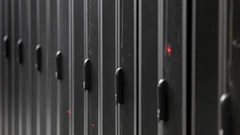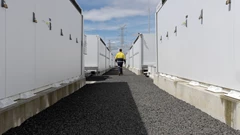The Century-Old Transmission Line Is Getting a 21st Century Upgrade
(Bloomberg) -- The green energy transition has been stymied by a lack of long-haul transmission lines to carry clean power from remote wind and solar farms to cities and power-hungry data centers where it’s needed.
The most discussed option is building more transmission projects. But startup TS Conductor Corp. says the key to addressing the shortfall isn’t just adding lines to the grid; it’s installing better ones that can deliver more electricity and potentially lower costs.
The Huntington Beach, California-based company, which was recognized as a BloombergNEF Pioneer this week, has developed a power cable that weighs less and can carry more electricity than the standard wires that have been used for more than a century. While lining up permits and approvals to build new transmission projects can take years, TS Conductor contends that utilities can boost capacity now by replacing existing towers’ wires with its product. Tests are already underway, including by the Tennessee Valley Authority.
“We’ve used the same conductor for the past 100 years,” said Chief Executive Officer Jason Huang. “This is a different kind of wire.”

Next-generation power lines remain a fairly niche product, but they could prove vital in the coming years. The world has a tall task to create grids that align with net-zero emissions goals. Adapting and expanding grids to meet net-zero needs by 2050 amounts to at least $21.4 trillion, according to BNEF. That includes installing nearly 50 million miles (80 million kilometers) of wires to transmit and distribute clean energy.
The industry standard for long-distance conductor — the technical name for this type of transmission wiring — wraps strands of aluminum that carry power around a steel core to provide strength and support. While the technology is tried and true, surging electricity demand from artificial intelligence, electric vehicles and other sources will require a grid overhaul
TS Conductor’s solution is to replace the steel with a carbon fiber core, which is stronger and about 80% lighter. The change means the core can be thinner and the product can pack more strands of aluminum in the same size conductor. Huang says his product can carry as much as three times more electricity than today’s wires.

While this type of advanced conductor can be two to three times the cost of conventional wiring on a per-foot basis, the lighter weight means utilities need fewer and shorter towers when installing miles and miles of it. For example, one customer that TS Conductor declined to name used the company’s product for an 11-mile (18-kilometer) connection to a wind farm. Using conventional conductor would have required 78 towers, but this job only needed 59 of them, Huang said. Fewer towers translates to less steel and concrete and lower labor costs.
“The total project is cheaper,” said Huang.
Advanced conductor designs are still new to the industry, and remain expensive and not widely used. However, they offer numerous advantages, and will likely become more common in the near future, according to Eric Holdsworth, managing director of clean energy and environmental policy for the Edison Electric Institute, a utility industry trade group.
“There’s no doubt we need to build more transmission,” said Holdsworth. “But if we can get more out of today’s grid, that’s less we need to build.”

The West and South regions of the US are where the transition is likely to happen first. Wildfires and hurricanes are becoming more severe threats, and utilities are already trying to make their grids more resilient. Advanced conductor can be stronger than current cables, making it attractive to utilities seeking to make their systems more resistant to natural disasters.
Early results from the Tennessee Valley Authority’s tests of TS Conductor’s technology are promising. The utility strung the conductor between two towers at a retired coal power plant in Alabama last year to see how it performed.
TVA is conducting additional lab tests, and if the results are good, it’s looking at five projects where it could replace about 76 miles of existing conductor. (That’s a sliver TVA’s grid, which spans roughly 16,000 miles.) Workers also said it was comparable to installing traditional wiring, which could make the transition to using it easier.
Some of TVA’s wiring is 75 years old, said Scott Fiedler, a spokesman for the authority, which is owned by the US government and serves 10 million people. That means a lot of old conductor out there is ready for replacement. And it’s not just the TVA system that’s ripe for new long-term transmission cables.
“It’s something that’s probably needed around the nation,” he said.
©2024 Bloomberg L.P.
KEEPING THE ENERGY INDUSTRY CONNECTED
Subscribe to our newsletter and get the best of Energy Connects directly to your inbox each week.
By subscribing, you agree to the processing of your personal data by dmg events as described in the Privacy Policy.
More renewables news

GE Vernova Expects More Trouble for Struggling Offshore Wind Industry

GE Vernova to Power City-Sized Data Centers With Gas as AI Demand Soars

Longi Delays Solar Module Plant in China as Sector Struggles

Australia Picks BP, Neoen Projects in Biggest Renewables Tender

SSE Plans £22 Billion Investment to Bolster Scotland’s Grid

A Booming and Coal-Heavy Steel Sector Risks India’s Green Goals

bp and JERA join forces to create global offshore wind joint venture

Blackstone’s Data-Center Ambitions School a City on AI Power Strains

Chevron Is Cutting Low-Carbon Spending by 25% Amid Belt Tightening
















